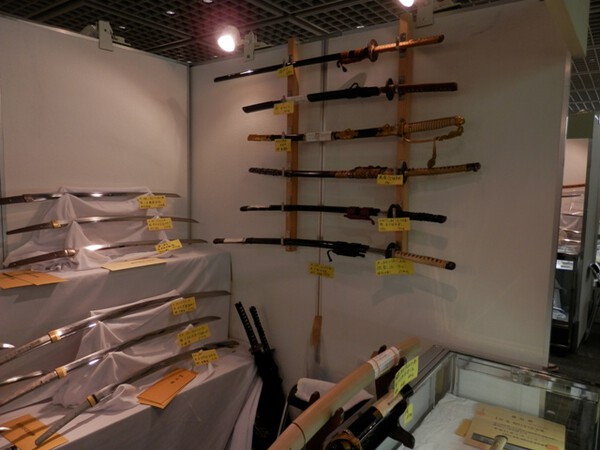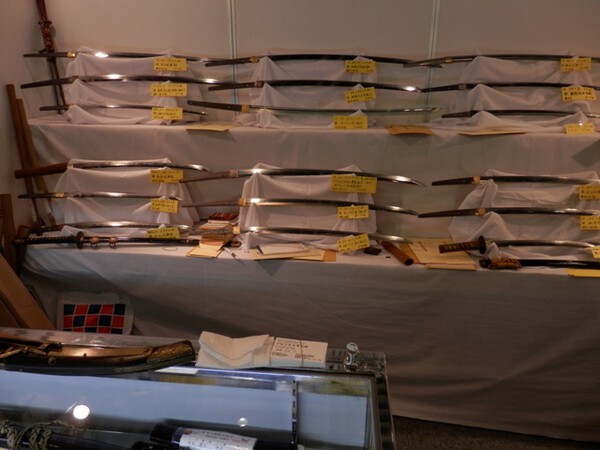-
Posts
506 -
Joined
-
Last visited
-
Days Won
33
Content Type
Profiles
Forums
Events
Store
Downloads
Gallery
Everything posted by Baka Gaijin
-
Hi Mike., The pattern of the constellation looks like the Little Dipper not the Big Dipper, the bottom star (closest to the compass) is likely to be the Pole Star, you may find more info by researching Myōken 妙見 and Onmyōdō 陰陽道. Cheers
-

Tokyo report
Baka Gaijin replied to Jean's topic in Sword Shows, Events, Community News and Legislation Issues
-

Tokyo report
Baka Gaijin replied to Jean's topic in Sword Shows, Events, Community News and Legislation Issues
Just back from Japan., DTI was again an excellent learning experience for me. Actually met Jean at Robert's Benkyokai, and his accent is best described as a suave combination of Maurice Chevalier, Charles Trenet, Jean Dujardin with a little Piaf.... On the Holiday Monday, one of the highlights of my trip was the Meiji Jingu Embu organised by the Nihon Kobudo Shinkokai. A host of Koryu schools showing both their armed and unarmed forms. There was also a Yabusame parade and demonstration on a specially prepared track. Inspirational!! Cheers -

Edo Period Corner Part II
Baka Gaijin replied to estcrh's topic in General Nihonto Related Discussion
Evening HJ Link works here in UK. Cheers -

Honjo Masamune found!! (well almost... maybe)
Baka Gaijin replied to Adrian S's topic in General Nihonto Related Discussion
Hi Guido, what is a Monbusho investigator please? Google says no..... Cheers -

Edo Period Corner Part II
Baka Gaijin replied to estcrh's topic in General Nihonto Related Discussion
Here ya go: http://www.thejapaneseconnection.com/mm ... e=Takazawa Cheers -

Kanji and Mon on Jingasa - translation help
Baka Gaijin replied to Jorgensen's topic in Translation Assistance
Good morning Jimi san., I can't be much help here, save to say that two rectangles intertwined in a Kamon are sometimes referred to as Kumiawase. Cheers -
Morning all., Also the Tsuba is 1st pattern and the Saya has the early chape (Ishizuki). http://ohmura-study.net/957.html Altogether a rareity. Cheers
-
Good evening ZHANG., These work very well: http://www.tozandoshop.com/Genuine-Leat ... chi33s.htm Cheers Malcolm
-
Hi Johnny., Check that there is a small piece of paper (Torokusho) with the sword in Japan, unlicensed swords are illegal in Japan, it's a really big deal. This should help to explain the situation: http://www.jssus.org/nkp/japanese_sword_laws.html Cheers
-
Good afternoon all Style and placement of numbers on Habaki is also another giveaway to it's origins.......as well perhaps where you saw it. Price? What you are prepared to pay for it. $15 - $20 sounds about right. Cheers
-
I think you've nailed it Guido
-
Could it be a Baku 獏 (Supernatural being that devours dreams and nightmares)? Cheers
-
Chris said 素晴らしい! ありがとう、森田さん。。。 Ditto
-
Good morning Jorgensen Jimi - san., This should help you understand how papers are structured: http://www.nihontocraft.com/japanese_sword_papers.html Most other Kanji you require will be here: http://www.jssus.org/nkp/index.html If you get stuck, ask again. Cheers
-
Good evening Robert, I looked and thought Ando also. I'd heard the blocks of Ando were recut in 1900, so I thought, recut printed on Chirimen....Tourist and Export market. But the signature was wrong, that made me go to the 2 versions of San Ju Roku, and search through them. Then the hunt was afoot. I've learned a great deal today from this. Including how Ando was in charge of a Fire fighting unit as part of his Samurai duties. Thank you
-
Hi Grev., This may help: Treasures of the San Diego: Exhibition at the Philippine Consulate New York from November 1, 1996 to February 28, 1997 Desroches, Jean-Paul & Casal, Fr. Gabriel & Goddio, Franck, 380 pp., profusely illustrated in color, bibliography, list of illustrations, paper, New York, 1996 Le San Diego: Un Tresor Sous La Mer. Dominique Carre. Reunion des Musees Nationaux. Paris. 1994. ISBN 2-7118-3135-3. http://www.franckgoddio.org/projects/an ... diego.html http://www.ieasm.org/ships.php?lang=fr& ... hip_type=G http://www.shibuiswords.com/sandiego.htm Here's a thread I opened on NMB back in 2011: viewtopic.php?f=2&t=7078&view=previous Cheers
-
Good morning all, Only just spotted this thread, Peter & Robert, I believe the print is not by Ando Hiroshige but by Utagawa Hiroshige IV. It is known as Twilight Hill at Meguro in the Eastern Capital. From the series Thirty-six Views of Mt. Fuji The print series is believed to have been originally produced early 20th Century, certainly after 1911. In this case on crepe paper known as Chirimen-gami-e. (Which suggests export or Tourists item). For those who fancy a bit of Sunday morning Soap Opera: The line of Hiroshige which is considered by some to be dubious and filled with sometimes bitter intrigues runs: Jūemon Tokutarō known as Hiroshige "Ando" and Utagawa Hiroshige I - 1797 -1858 Suzuki Chimpei known as Hiroshige "Shigenobu" and Utagawa Hiroshige II Given the "Gō" Official Art Name by Hiroshige I, on the celebration of marriage to Hiroshige I's daughter Otatsu whom he later divorced. Signed later as Ryūshō. Ended up painting lanterns to survive. died 1869 Gotō Torakichi known as Hiroshige "Shigemasa" as Utagawa Hiroshige III also married Otatsu and also used the name Hiroshige II and Andō Tokubei for a while, then used Hiroshige III died 1894. Kikuchi Kiichiro later Ryusho II known as Utagawa Hiroshige IV took the name in 1911 I get the feeling he was essentially a pastiche Artist working in a style similar to the preceding three (Can't find other dates for him). Bestowing of the Gō was the official sanction that you and your work was worthy of the name. A bit like product endorsement...... Cartier not Kartier, Rolex not Roleks Sources: http://ukiyo-e.org/image/chazen/1980_2303 http://books.google.co.uk/books?id=p2Qn ... IV&f=false http://www.hiroshige.org.uk/hiroshige/w ... e_eras.htm http://viewingjapaneseprints.net/texts/ ... rimen.html Cheers
-
Good afternoon Robert., Is it a full wrap same or is there a join line on the omote side? If it's a full wrap, it suggests that someone cared that the tsuka would be strong The thickness of the tsuba reminds me of the type used in Maniwa Nen Ryu: http://blog.goo.ne.jp/isyota/e/9b8907ff ... 8108a01e87 https://www.flickr.com/photos/oroshi/8958080504/ I have never seen a Koshirae like this before, perhaps one of our senior members has. Cheers
-
Good morning all., Thank you Robert, for posting more images of the Koshirae, it really is an interesting item. The absence of a Kurikata does not mean it could not be worn in a training environment. The tightness of the Obi and Hakama Himo determine whether a saya slips or not, the Kurikata has very little to do with it. The saya wrap looks like a split grass or some vegetable fibre which has been bound very tightly around the saya and laquered. Ages ago Tsuruta san had a sword in his Iai section which had similar wrap over Kojiri and Kashira, as I recall he described the Koshirae as late Edo, specifically for Iai training. The Koshirae looks like it was meant for some serious useage. Again thank you for posting the extra images. Cheers
-
Morning all, The question arises in my mind, is it from indigenous Japanese species, or an exotic import? Burmese Blackwood, Dalbergia Cultrata which is variously known as Khamphi Rosewood, Laos Rosewood looks close to it http://www.wood-database.com/lumber-ide ... blackwood/ Here's the complete database for reference: http://www.wood-database.com/ Brownheart, Wacapou, Vouacapoua americana was another thought, but that's from South America Cheers
-
Good morning Thomas., My feeling is that this is a really rare example of a practical training Koshirae. I was first thinking something like Tennen Rishin Ryu or full on Jigen Ryu. I noticed particularly the ferrule reinforcement at the area from Kurikata to Koiguchi. Then because of the leather padding on a wooden tsuba, I wondered if it was primarily a receiving sword. The striking sword being a Bokuto. Which kind of shoots my Jigen Ryu theory down as the concept of blocking is anathema. Perhaps one of the Itto ryu variations? Hokushin Itto Ryu could be a contender as that was known from Aizu and Northwards. Could it have been owned by one of the Shinsengumi Bad Boys gone North? The last statement was a shameless attempt at obtaining a Manga/Anime Otaku 101 credit..... Back to rationality, we know from the writings of Tesshu Yamaoka, Uyeshiba Morihei and Takeda Sokaku that specialised training weapons such as extra heavy Bokuto for Tanren training or Iron bars for So-Jutsu were used: I'd like to see more pictures of the entire Koshirae. Cheers
-
Morning all., The edge is dull and the tsuba is padded leather. (Is the term for a completely dull edge Habiki?) Might this have been used for Gekken (Severe Sword - I think) training? Bearing in mind the period and the warriors who also went North. Hokkaido, a generation later being akin to the Wild West, the birthplace of the early manifestation of both the fledgling Aiki Jutsu (later Do) under Uyeshiba Morihei and the allegedly pre existing Daito Ryu forms of Takeda Sokaku. Just a thought. Malcolm
-
Hi Dan C & John., Cannon were cast in Bakumatsu period Edo at Itabashi, near Akabane : http://www.city.itabashi.tokyo.jp/c_kur ... 34964.html Here's a close up of the Blast Furnaces: http://www.city.itabashi.tokyo.jp/c_kur ... 1.jpg.html Cheers




